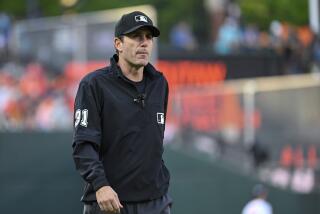Umpires Will Be Zoning In
- Share via
VERO BEACH, Fla. — The 30 major league teams have been notified in a directive from the commissioner’s office that the rule-book parameters of the often elusive strike zone will be strictly enforced this year. The directive was distributed Friday and obtained by The Times on Sunday.
“There’s been a lot of criticism over the variance in leagues and umpires,” Commissioner Bud Selig said when reached at his vacation home in Arizona. “We believe the strike zone should be enforced the way it appears in the book.”
Dodger Manager Davey Johnson, among others, didn’t think there would be a dramatic difference.
“We’ve had a published strike zone for like 200 years now and it’s always been at the discretion of each individual umpire,” Johnson said. “Some have a high zone and some have a wide zone. You can’t just ask umpires who grew up with a certain zone to adhere to a new one. I mean, it’s always been the job of the hitter and pitcher to recognize the strike zone on that particular night and adjust accordingly.”
Selig acknowledged that the human element is a factor in the variance “but we believe the rule book is pretty clear-cut.”
Said a source familiar with the directive: “There’s always been a difference between the leagues, but we’ve been surprised at the [increasing] differences within the leagues. You can never achieve total conformity because of the human element, but there’s need for improvement.”
The source said that the directive has two objectives: to encourage National League umpires, who have a tendency to expand the width of the plate in calling strikes on pitches that appear wide of the inside and outside of the plate’s parameter, to narrow that zone back back to rule book specifications and to get umpires in both leagues to call the high strike. As it is now, umpires seldom call a strike on a pitch above the belt. The high strike is described in the rule book as a horizontal line midpoint between the top of the shoulders and the top of the uniform pants.
The directive, however, goes on to say that “this parameter may be difficult to determine precisely” and it modifies it by saying, “the upper limit of the strike zone will [now] be two inches above the top of the uniform pants.”
That unilateral modification could be contested by the players union since those rules are subject to collective bargaining, the source said. In addition, the two-inch parameter figures to task umpires of different sizes and stances as they attempt to determine whether a 90-mile-per-hour fastball is above or below that outer limit.
“I don’t see how veteran umpires are going to change their strike zone,” Dodger second baseman Eric Young said. “Everybody has their own definition of it. I’m a little guy. I have to see what the umpire is calling and adjust, but if the pitchers are going to start pitching up because they think they’re going to get the call on the high strike, the big guys will take it out of the park, and that will stop it right there.”
The Major League Umpires Assn. concluded regularly scheduled meetings in Phoenix on Saturday, but veteran American League umpire Davey Phillips, reached Sunday at his St. Louis home, said he was unaware of the directive--”although there has been speculation that there would be a strong push to do that.”
He said crew chiefs are scheduled to meet with their respective league presidents on March 1 and that they could be informed at that time.
“I have a strike zone that I’ve perfected in my mind during more than 30 years in the profession,” Phillips said, “but if they want me to call a higher strike zone I can do it, and we have enough talented umpires that it can be done, but there are going to be some ejections and arguments.
“I think baseball needs to define a universal strike zone that everyone understands and agrees with. The way it is now, the general managers, managers and players all have a different version of what it should be.”
The variances have been illuminated embarrassingly in the last two playoffs. National League umpire Eric Gregg’s remarkably wide strike zone was strongly criticized by the Atlanta Braves in Game 5 of the 1997 championship series as Livan Hernandez of the Florida Marlins recorded 15 strikeouts, and American League umpire Joe Brinkman’s ball and strike calls came under such fire in Game 2 of the 1998 divisional series between Boston and Cleveland that Cleveland starter Dwight Gooden and Manager Mike Hargrove were ejected in the first inning.
*
HE’S OUT
Gary DiSarcina broke a bone in his arm in a freak accident. Page 5
By the Book
The definition of Major League Baseball’s strike zone, according to Rule 200 of the Official Baseball Rules, reads as follows:
“The strike zone is that area over home plate the upper limit of which is a horizontal line at the midpoint between the top of the uniform pants, and the lower level is a line at the hollow beneath the kneecap. The strike zone shall be determined from the batter’s stance as the batter is prepared to swing at a pitched ball.”
More to Read
Go beyond the scoreboard
Get the latest on L.A.'s teams in the daily Sports Report newsletter.
You may occasionally receive promotional content from the Los Angeles Times.










